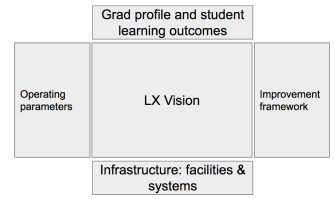School networks make the challenging work of personalized learning possible at scale. Whether managed (Brooklyn LAB, Summit Public Schools, Rocketship), voluntary (New Tech Network, NAF) or a school district (all or part) that acts like a network (Yellow Springs Ohio or Beacon Schools in Denver), like minded schools share an approach to learning and some associated resources.
The challenge is finding the balance between a dictatorial search for instructional fidelity and a free for all of empowerment that results in big differences in results. The new challenge is how to create a generative network that learns together (especially across multiple contexts) with just enough framing and support to attract and retain great talent and create network effects (ie, getting better with scale)
Step one is building a vibrant vision of student learning experience (LX). In what kinds of learning tasks are students engaged? How do they demonstrate learning? In what ways do they build and exercise agency over learning? How do they progress through levels of learning? Next, add a north star of learning goals--a graduate profile and learning outcomes at each stage.

Support goal achievement with an improvement framework. Carnegie Foundation calls it Networked Improvement Communities-- improvement principles and process strategies. Stanford d.school calls the process design thinking. Solution Tree advocates Professional Learning Communities--a process and a structure for improvement.
The Innovation Cycle at Summit Public Schools follows a Build, Measure, Learn approach across a mixture of vertical and horizontal teams--they explore data, identify problems and challenges, develop and implement solutions, and then check back with the data.
Every network shares a set of operating parameters. They include stakeholder bargains and constraints that need to be monitored, complied with and periodically renegotiated. These dictate funding, measurement, communication and schedules. Some loose networks (think Future Ready Schools schools) don’t get involved in parameter setting while districts and charter management organizations set almost all of the operating parameters for schools.

And finally, network leaders provision learning infrastructure. Platform networks (like New Tech Network) provide a platform and professional learning experiences that support a common learning model. Like the improvement framework and operating parameters, the trick is providing enough but not too much infrastructure.
Take Facebook as an example of dynamic infrastructure--there’s not just one version of Facebook. “At any point in time there are probably 10,000 versions,” said CEO Mark Zuckerberg. “Any engineer can test something with 10,000 or 50,000 people, whatever is necessary to get a good test. Then, they get a read out of all of metrics we care about: how are people connecting and sharing, do people have more friends, does it improve efficiency?”
If it worked, the engineer takes the idea to a manager to incorporate into the base code. If not, they add it to the documentation of failed trials. As it approaches 2 billion users, Facebook remains a dynamic network where Zuckerberg says the goal is to “Learn as quickly as possible what our community wants us to do.”
Three things enable Facebook’s strategy of learn and go as fast as you can: a culture that encourages people to try things; infrastructure that allows people to do that (i.e., run 10,000 versions simultaneously); and a testing framework that helps determine how well the trial worked.
We’ve suggested that dynamic networks share generously, learn bottom up and outside in, and frequently update their infrastructure (think automatic software-as-a-service updates).
This blog is part of a multi-year campaign studying networks and their effect on education and transformation. Our work will culminate in a book publishing in 2018. Learn more and join the conversation using #NetworkEffect.
For more see: